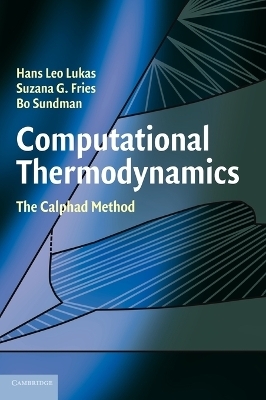
Computational Thermodynamics
Cambridge University Press (Verlag)
978-0-521-86811-2 (ISBN)
Phase diagrams are used in materials research and engineering to understand the interrelationship between composition, microstructure and process conditions. In complex systems, computational methods such as CALPHAD are employed to model thermodynamic properties for each phase and simulate multicomponent phase behavior. Written by recognized experts in the field, this is an introductory guide to the CALPHAD method, providing a theoretical and practical approach. Building on core thermodynamic principles, this 2007 book applies crystallography, first principles methods and experimental data to computational phase behavior modeling using the CALPHAD method. With a chapter dedicated to creating thermodynamic databases, the reader will be confident in assessing, optimizing and validating complex thermodynamic systems alongside database construction and manipulation. Several case studies put the methods into a practical context, making this suitable for use on advanced materials design and engineering courses and an invaluable reference to those using thermodynamic data in their research or simulations.
Hans Leo Lukas received his PhD from the Max-Planck Institute of Metals Research in 1960, he continued his research here from 1964 until he retired in 1995. Among numerous responsibilities over the years, he was co-editor of the Calphad Journal from 1979 until 2003. Suzana G. Fries received her PhD in Science from the Physics Institute at the Universidade Federal de Rio Grande do Sol in 1985. Following professorships and research at several universities, she is currently a freelance consultant. Bo Sundman received his PhD from the Royal Institute of Technology (KTH) in 1981. He is currently a professor for the CIRIMAT and ENSIACET groups at the Paul Sabatier University, Toulouse, France. A member of the editorial board of the Calphad Journal, he is also an initiator and board member of Thermo-Calc software AB, and one of the software developers. He is a founder and board member of the Foundation for Computational Thermodynamics and in 2002 received the Gibbs Triangle Award from the Calphad Society.
Preface; 1. Introduction; 2. Basis; 3. First principles and thermodynamic properties; 4. Experimental data used for the optimisation; 5. Models for the Gibbs energy; 6. Assessment methodology; 7. Optimisation tools; 8. Creating thermodynamic databases; 9. Case studies; Bibliography; Index.
| Erscheint lt. Verlag | 12.7.2007 |
|---|---|
| Zusatzinfo | 3 Halftones, unspecified; 93 Line drawings, unspecified |
| Verlagsort | Cambridge |
| Sprache | englisch |
| Maße | 181 x 247 mm |
| Gewicht | 800 g |
| Themenwelt | Informatik ► Grafik / Design ► Digitale Bildverarbeitung |
| Mathematik / Informatik ► Informatik ► Theorie / Studium | |
| Mathematik / Informatik ► Mathematik ► Angewandte Mathematik | |
| Technik ► Maschinenbau | |
| ISBN-10 | 0-521-86811-4 / 0521868114 |
| ISBN-13 | 978-0-521-86811-2 / 9780521868112 |
| Zustand | Neuware |
| Haben Sie eine Frage zum Produkt? |
aus dem Bereich


